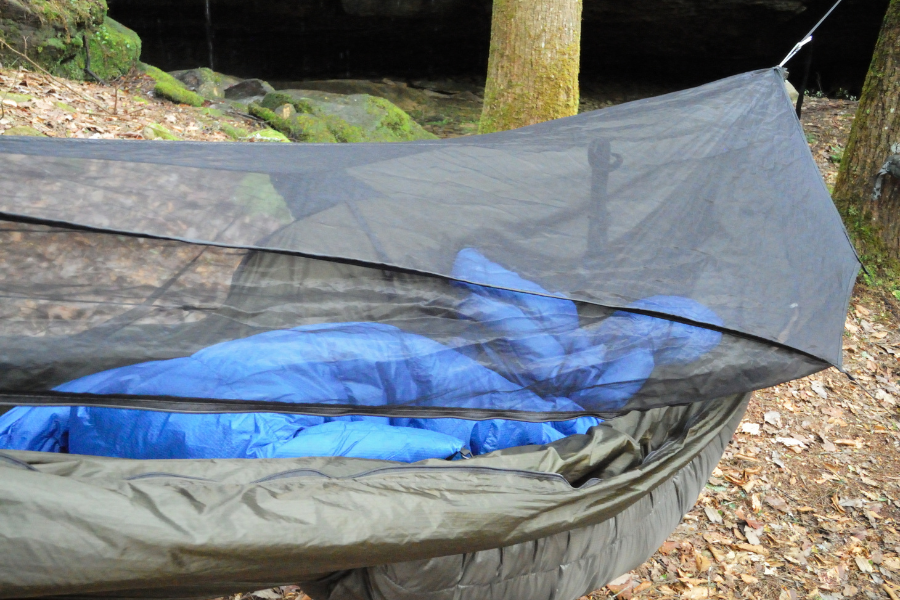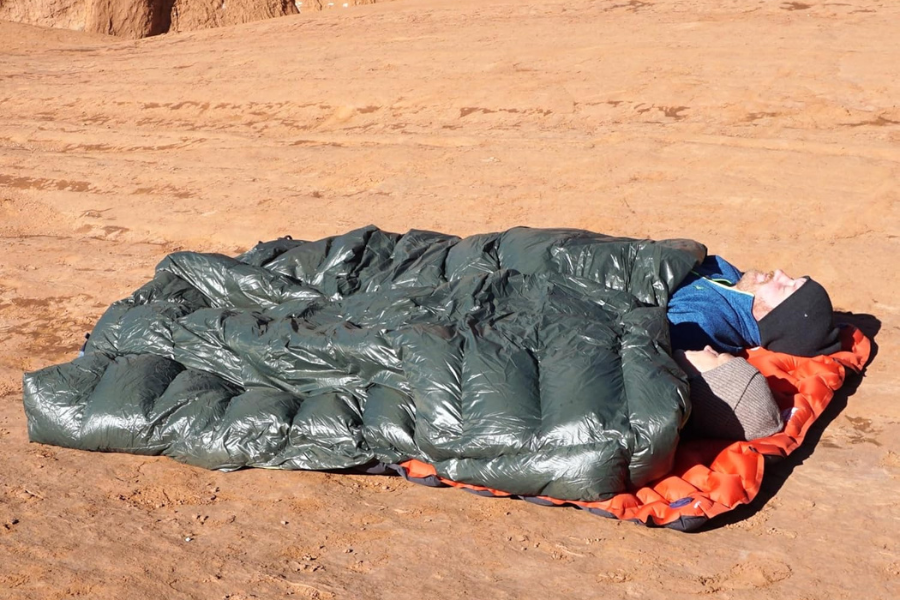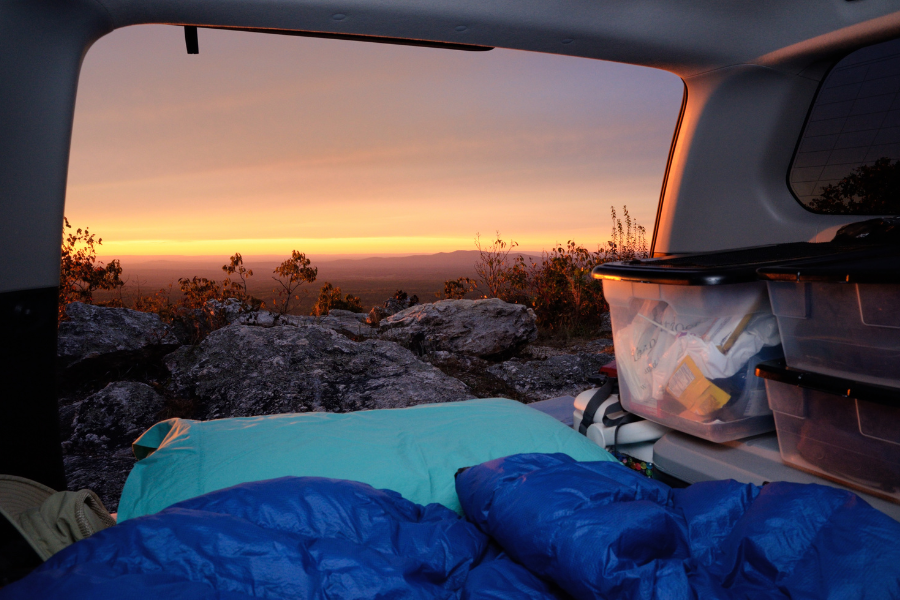Camping Quilt vs. Sleeping Bag: A Comprehensive Guide to Camping Quilts
Key Takeaways:
Understanding Quilt Types: Learn the differences between various types of camping quilts and how they cater to different camping needs.
Contrast Quilts with Sleeping bags to help you make a decision which is best suited for your adventures.
Choosing the Right Quilt: Key factors to consider when selecting a camping quilt, including temperature ratings, fill power, and weight.
Maintenance and Care: Tips on how to care for your camping quilt to ensure longevity and optimal performance.
Introduction to Camping Quilts
Camping quilts are a relatively new addition to the world of camping gear.
Unlike traditional sleeping bags, camping quilts offer versatility, lighter weight, and often a more comfortable sleeping experience.
This guide will delve into everything from the basics of what a camping quilt is to how to choose and care for one, ensuring you make the most out of your outdoor adventures.
What is a Camping Quilt?
They are essentially a blanket with a lot of insulation. It’s made with a variety of materials but typically includes a comfortable layered construction like down or synthetic fill, making it lightweight.
A camping quilt, often referred to as sleeping quilts, is a lightweight alternative to full zip sleeping bags.
Designed with minimalism in mind, these quilts provide warmth and comfort without the added bulk and weight of traditional mummy bags.
They are perfect for ultralight backpackers and those looking to save weight without sacrificing warmth.
Camping Quilt v Sleeping Bag
A sleeping bag is a standard option for most campers because of its ability to provide warmth on cold nights, water resistance, and excellent wind protection.
They come in a variety of weights and insulation levels, making them suitable for different climates and conditions.
They are also more versatile than camping quilts since they offer full coverage from head to toe.
One of the main benefits of sleeping bags is their ability to keep you warm in even the coldest weather.
I find this means for me that I can keep warm from my neck to my toes within the bag and am less likely to lose heat.
A sleeping bag can also be very comfortable, providing a range of temperature regulation, and padded insulation underneath you. If you are like me and get cold at night, this is a good choice.
One of the drawbacks of sleeping bags is that they can be heavier and bulkier than camping quilts.
Unlike traditional sleeping bags, most quilts do not have a full-length zipper or a built-in hood, reducing weight and bulk.
Let’s dive in further to some benefits of a camping quilt.
Camping quilts can be an integral part of a versatile sleep system, especially given their adaptability to a wide range of temperatures and conditions, enhancing their utility across various outdoor scenarios.

Benefits of Using a Camping Quilt
As mentioned, one of the main benefits of a camping quilt is that they are generally lighter and more compact than a sleeping bag.
They are also easier to get in and out of, making them a good choice for those who tend to get up in the night.
Using a quilt when camping provides considerable freedom of movement and the ability to regulate your temperature better. If you’re someone who tends to get hot quickly and then cold after a while, then a camping quilt would be a good option for you.
The quilt is also great for ultra-light enthusiasts that need to minimize their packing weight and makes them ideal for backpackers or anyone who is short on storage space.
One of the drawbacks of camping quilts is that they don’t offer the same level of protection from the elements as a sleeping bag.
Since they don’t have a hood or a built-in footbox, they are best used in warmer weather or in combination with a bivy sack.
Innovative Features of Modern Camping Quilts
Camping quilts have evolved significantly, incorporating features that cater to the diverse needs of outdoor enthusiasts.
For instance, the Enlightened Equipment Revelation quilt stands out with its ability to open up fully, doubling as a blanket on warmer nights, or can be cinched tight to retain heat during colder times.
This versatility ensures that whether you’re facing the brisk winds of the Oregon Coast or enjoying a mild night under the stars, your quilt adapts seamlessly.
The integration of such adaptable features speaks volumes about the innovation driving today’s outdoor gear industry.
Moreover, the focus on using high-quality materials in quilts like the Magma Trail Quilt (available at REI) not only enhances durability but also ensures comfort and efficiency in insulation.
These quilts often employ advanced fabrics that are both lightweight and capable of handling rough outdoor conditions.
For thru-hikers or anyone embracing ultralight backpacking, this means carrying a quilt that offers substantial warmth without the burden of extra weight.
The strategic use of materials and design innovations clearly demonstrates how modern quilts are more than just sleeping aids; they are a pivotal part of your outdoor gear.
Choosing the Best Backpacking Quilt for Temperature Ratings
When selecting a camping quilt, it’s crucial to consider the temperature ratings.
Quilts are designed to provide comfort at specific temperature ranges, and choosing one that matches the typical conditions you camp in will ensure you stay warm.
Whether it’s cooler temperatures or milder shoulder seasons, there’s a quilt designed to meet those conditions.
Fill Power and Its Importance
Fill power is a critical factor in the performance of down quilts.
Higher fill power indicates more loft and better insulation properties, which translates to more warmth per ounce of down.
This makes high fill power quilts ideal for cold sleepers or winter camping scenarios where maintaining warmth is crucial.
Quilts for Different Types of Sleepers
The versatility of camping quilts makes them suitable for various sleepers.
Side sleepers, warm sleepers, and those who move a lot in their sleep will find the flexibility of a quilt more comfortable and less restrictive than traditional bags.
Quilt Versatility for Different Climates and Activities
The adaptability of camping quilts to various environmental conditions makes them an invaluable asset for any outdoor adventure.
Quilts like the Therm-a-Rest ultralight quilt are designed to provide optimal warmth without the bulk typically associated with traditional sleeping bags.
This is particularly beneficial for adventurers who tackle environments from sub-freezing temperatures to mild climates.
The ability to adjust the level of insulation, often through features like footbox adjustments or additional down fill sections, allows users to customize their sleeping experience according to the night’s demands.
In addition to temperature adaptability, many of the best backpacking quilts are designed with activities in mind.
For instance, lighter quilts with lower fill power are perfect for summer backpacking trips where weight savings are crucial, while heavier, more insulated quilts cater to cold nights in the backcountry.
This specificity in design not only caters to the body weight and warmth needs of the sleeper but also complements other gear like down jackets and the best ultralight tents, creating a cohesive and functional gear setup that enhances the overall outdoor experience.

Camping Quilts for the Ultimate Hammock Experience
Unlike traditional sleeping bags, camping quilts offer unparalleled versatility and ease of use, especially when paired with a hammock.
They’re designed to wrap around you, providing warmth without the restrictive feel of a sleeping bag.
The Role of Durable Water Repellent (DWR)
Many high-quality quilts feature a durable water repellent coating.
This treatment helps the quilt resist moisture and maintain its insulative properties even in damp conditions, making it a reliable companion for outdoor adventures.
Essential Accessories for Your Camping Quilt
When venturing into the great outdoors with your best backpacking quilt, consider pairing it with essential accessories to maximize comfort and functionality.
A compression sack is a must-have, as it compresses your down quilt into a compact, easy-to-carry bundle, saving weight and space in your backpack.
This is particularly useful for thru-hikers who count every ounce. Additionally, a high-quality sleeping pad not only adds an extra layer of comfort but also enhances the quilt’s ability to retain heat, ensuring you stay warm even on chilly nights.
Another accessory worth considering is a quilt liner.
This handy addition not only keeps your quilt clean, extending its lifespan, but can also add a few degrees of warmth.
For those who frequently camp in warmer temperatures, a liner can be used alone on warm nights, making it a versatile choice.
Remember, the right accessories can make your first quilt more adaptable to various camping scenarios, from sub-freezing temperatures to balmy summer evenings, ensuring you get the most out of your outdoor adventures.
Understanding the Pad Attachment System
To prevent the quilt from shifting during the night, many models come with a pad attachment system.
This system helps secure the quilt to your sleeping pad, ensuring that warm air doesn’t escape and cold drafts don’t enter, which is essential for maintaining warmth throughout the night.
Maintenance and Care for Longevity
Proper care is essential to maintain the performance and longevity of your camping quilt.
Regular cleaning, appropriate storage, and careful handling will help preserve the quality of the down and the fabric, ensuring your quilt remains a part of your gear for many adventures to come.
Always follow the care instructions provided by the manufacturer.
Typically, down quilts should be washed sparingly and with a gentle detergent specially formulated for down.
Air drying is preferred, though a low heat setting in a large commercial dryer can help fluff the down back to its original loft.
Avoid storing your quilt compressed in a stuff sack; instead, use a larger storage sack where the quilt can remain lofted and breathable.
Moreover, regular maintenance like gently brushing off any dirt and airing out the quilt after each trip can significantly extend its life.
Be mindful of where you set up camp to avoid ground moisture and prickly surfaces that might damage the quilt.
Investing a little time in care can ensure that your down quilt remains a reliable companion for many more adventures, providing the same temperature rating effectiveness and comfort as when it was first purchased.

Cost Considerations: Budget Backpacking Quilt vs. Expensive Quilts
The cost of a camping quilt can vary widely based on materials, features, and brand.
While more expensive quilts typically offer better performance and durability, there are also best budget backpacking quilt options available that do not compromise significantly on quality and comfort.
Comparing Cost and Value: When to Invest in an Expensive Quilt
Deciding whether to invest in an expensive quilt can be like standing at a trailhead, pondering which path to take.
On one hand, expensive quilts typically utilize high-quality materials that promise durability and exceptional warmth, especially crucial in sub-freezing temperatures.
These materials, such as high-fill-power down or advanced synthetic fibers, not only provide superior insulation but also compress down more effectively, reducing pack space—a precious commodity on the trail.
On the other hand, the initial cost can be a hurdle.
However, for those who frequently camp in cold climates or embark on extended adventures, the upfront investment often pays dividends in comfort and reliability.
An expensive quilt, treated well, can be a faithful companion for countless nights under the stars, making it a worthwhile consideration for serious outdoor enthusiasts.
This is especially true when compared to other quilts that might offer initial savings but falter in harsh conditions or degrade after several seasons.
My Personal Choice
My personal choice, when it comes to sleeping gear, is a combination of both a camping quilt and a sleeping bag.
When I’m trekking or backpacking, I prefer using a sleeping bag for insulation – I get cold really easily!
However, when I’m comfort camping with friends and family, I enjoy using the quilt and blanket style which gives me a more home away from home feeling.
I also like the fact that I can unzip my sleeping bag and use it as a cozy warm pad underneath my quilt. This also minimizes the amount of gear I need to bring with me.
In the end, both camping quilts and sleeping bags have their own benefits and drawbacks. Finding the right fit for you depends on your specific needs and preferences.

Final Thoughts
Camping quilits offer a lightweight, versatile, and comfortable alternative to traditional sleeping bags.
Whether you’re a thru-hiker, a weekend warrior, or a cold sleeper, there’s a quilt out there that can enhance your camping experience.
By understanding the key features and proper maintenance, you can choose and care for a quilt that will serve you well across many outdoor adventures.
FAQ’s
Q: Can a camping quilt replace a traditional sleeping bag?
A: Yes, for many campers, a camping quilt can completely replace a traditional sleeping bag, especially in scenarios where weight and bulk are a concern. However, it’s crucial to choose a quilt with appropriate temperature ratings for your typical camping conditions.
Q: How do I choose the right size and fit for a camping quilt?
A: Consider your body size and sleeping habits. Most quilts come in various lengths and widths. A wider quilt might be preferable if you are a side sleeper or tend to move a lot in your sleep.
Q: What is the best type of insulation for camping quilts and sleeping bags?
A: The best insulating material for camping quilts and sleeping bags depends on a variety of factors, including your budget and the temperature conditions you might experience while camping. Down insulation is considered by many to be one of the best materials out there as it is warm, lightweight, and highly compressible. However, synthetic insulation is also a great option if you are looking for an affordable and sustainable alternative.
Q: Which one works better for camping with a hammock?
A: A camping quilt is the best choice if you plan on using a hammock. Quilts are designed to be used in combination with other gear, allowing you to easily attach it to your hammock for a comfortable night’s sleep. I find that sleeping bags used with hammocks are more difficult to work with due to their shape and size.




